|
|
Creator | Title | Description | Subject | Date |
| 201 |
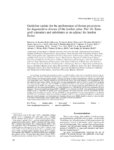 |
Dailey, Andrew T. | Guideline update for the performance of fusion procedures for degenerative disease of the lumbar spine. Part 16: Bone graft extenders and substitutes as an adjunct for lumbar fusion | In an attempt to enhance the potential to achieve a solid arthrodesis and avoid the morbidity of harvesting autologous iliac crest bone (AICB) for a lumbar fusion, numerous alternatives have been investigated. The use of these fusion adjuncts has become routine despite a lack of convincing evidence ... | | 2014-01-01 |
| 202 |
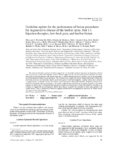 |
Dailey, Andrew T. | Guideline update for the performance of fusion procedures for degenerative disease of the lumbar spine. Part 13: Injection therapies, low-back pain, and lumbar fusion | The medical literature continues to fail to support the use of lumbar epidural injections for long-term relief of chronic back pain without radiculopathy. There is limited support for the use of lumbar epidural injections for short-term relief in selected patients with chronic back pain. Lumbar intr... | | 2014-01-01 |
| 203 |
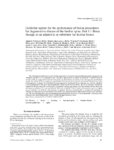 |
Dailey, Andrew T. | Guideline update for the performance of fusion procedures for degenerative disease of the lumbar spine. Part 14: Brace therapy as an adjunct to or substitute for lumbar fusion | The utilization of orthotic devices for lumbar degenerative disease has been justified from both a prognostic and therapeutic perspective. As a prognostic tool, bracing is applied prior to surgery to determine if immobilization of the spine leads to symptomatic relief and thus justify the performanc... | | 2014-01-01 |
| 204 |
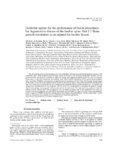 |
Dailey, Andrew T. | Guideline update for the performance of fusion procedures for degenerative disease of the lumbar spine. Part 17: Bone growth stimulators as an adjunct for lumbar fusion | The relationship between the formation of a solid arthrodesis and electrical and electromagnetic energy is well established; most of the information on the topic, however, pertains to the healing of long bone fractures. The use of both invasive and noninvasive means to supply this energy and supplem... | | 2014-01-01 |
| 205 |
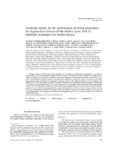 |
Dailey, Andrew T. | Guideline update for the performance of fusion procedures for degenerative disease of the lumbar spine. Part 11: Interbody techniques for lumbar fusion | Interbody fusion techniques have been promoted as an adjunct to lumbar fusion procedures in an effort to enhance fusion rates and potentially improve clinical outcome. The medical evidence continues to suggest that interbody techniques are associated with higher fusion rates compared with posterolat... | | 2014-01-01 |
| 206 |
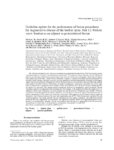 |
Dailey, Andrew T. | Guideline update for the performance of fusion procedures for degenerative disease of the lumbar spine. Part 12: Pedicle screw fixation as an adjunct to posterolateral fusion | The utilization of pedicle screw fixation as an adjunct to posterolateral lumbar fusion (PLF) has become routine, but demonstration of a definitive benefit remains problematic. The medical evidence indicates that the addition of pedicle screw fixation to PLF increases fusion rates when assessed with... | | 2014-01-01 |
| 207 |
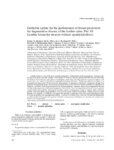 |
Dailey, Andrew T. | Guideline update for the performance of fusion procedures for degenerative disease of the lumbar spine. Part 10: Lumbar fusion for stenosis without spondylolisthesis | Lumbar stenosis is one of the more common radiographic manifestations of the aging process, leading to narrowing of the spinal canal and foramen. When stenosis is clinically relevant, patients often describe activity-related low-back or lower-extremity pain, known as neurogenic claudication. For tho... | | 2014-01-01 |
| 208 |
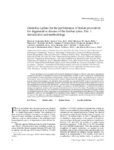 |
Dailey, Andrew T. | Guideline update for the performance of fusion procedures for degenerative disease of the lumbar spine. Part 1: Introduction and methodology | Fusion procedures are an accepted and successful management strategy to alleviate pain and/or neurological symptoms associated with degenerative disease of the lumbar spine. In 2005, the first version of the "Guidelines for the performance of fusion procedures for degenerative disease of the lumbar ... | | 2014-01-01 |
| 209 |
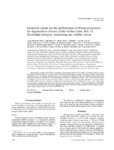 |
Dailey, Andrew T. | Guideline update for the performance of fusion procedures for degenerative disease of the lumbar spine. Part 15: Electrophysiological monitoring and lumbar fusion | Intraoperative monitoring (IOM) is commonly used during lumbar fusion surgery for the prevention of nerve root injury. Justification for its use stems from the belief that IOM can prevent nerve root injury during the placement of pedicle screws. A thorough literature review was conducted to determin... | | 2014-01-01 |
| 210 |
 |
Digre, Kathleen B.; Schmidt, Richard H.; Osborne, Anne G.; Patel, Bhupendra C.; Pratt, David; Rietz, Lisa A. | Compressive optic neuropathy caused by renal osteodystrophy. Case report. | Compressive optic neuropathy with acute or chronic vision loss has been associated with various skull base tumors, aneurysms, Graves disease, trauma, and, less commonly, fibrous dysplasia and osteopetrosis. The Author's present a case of acute visual deterioration in a 25-year-old woman who had mass... | Optic Neuropathy; Optic Nerve Decompression; Renal Osteodystrophy | 2001-10 |
| 211 |
 |
Couldwell, William T. | History and evolution of transsphenoidal surgery | Initial attempts at transcranial approaches to the pituitary gland in the late 1800s and early 1900s resulted in a mortality rate that was generally considered prohibitive. Schloffer suggested the use of a transsphenoidal route as a safer, alternative approach to the sella turcica. He reported the f... | Neurosurgical history; Transsphenoidal surgery; Pituitary tumor | 2001 |
| 212 |
 |
Couldwell, William T. | False-negative magnetic resonance angiography with extracranial internal carotid artery stenosis: a report of two cases and review of the literature | Magnetic resonance angiography (MRA) is increasingly used as a noninvasive means to assess internal carotid artery (ICA) stenosis. When used alone, however, MRA may not be sufficiently accurate in certain settings to determine whether ICA disease meets surgical criteria. Although MRA has been recogn... | Internal carotid artery stenosis; Magnetic resonance angiography | 2005 |
| 213 |
 |
Couldwell, William T.; House, Paul A.; Salzman, Karen L.; Osborne, Anne G.; MacDonald, Joel D.; Jensen, Randy L. | Surgical considerations regarding giant dilations of the perivascular spaces | Object. Dilations of brain perivascular spaces (PVSs), also known as Virchow-Robin spaces, are routinely identified on magnetic resonance imaging studies of the brain and recognized as benign normal variants. Giant dilations occur only rarely and can be easily misdiagnosed as central nervous system ... | | 2004 |
| 214 |
 |
Couldwell, William T. | Diagnosis and management of Cushing disease | The management of a case involving Cushing disease, defined as excess secretion of adrenocorticotropic hormone (ACTH) from a pituitary adenoma, remains one of the most vexing problems facing the pituitary surgeon. The systemic consequences of this endocrinopathy are profound morbidity and premature... | | 2007-01-01 |
| 215 |
 |
Kestle, John R. W. | Sporadic osteochondroma of the cervical spine | Osteochondroma is the most common benign tumor of bone, but axial skeleton involvement is uncommon and usually indicates a hereditary cause such as osteochondromatosis (hereditary multiple exostosis). 1 Approximately 7% of hereditary osteochondromas occur along the vertebral column, which is double... | | 2006 |
| 216 |
 |
Schmidt, Meic H. | Thoracoscopic spine surgery for decompression and stabilization of the anterolateral thoracolumbar spine | The anterior thoracolumbar spine can be exposed via a variety of approaches. Historically, open anterolateral or posterolateral approaches have been used to gain access to the anterior thoracolumbar spinal column. Although the exposure is excellent, open approaches are associated with significant pa... | Endoscopic spinal surgery; Thoracic spine; Lumbar spine; Thoracoscopic spinal instrumentation | 2005 |
| 217 |
 |
Couldwell, William T. | Inhibition of cellular growth and induction of apoptosis in pituitary adenoma cell lines by the protein kinase C inhibitor hypericin: potential therapeutic application | Protein kinase C (PKC) is an enzyme involved in the regulation of cellular growth, proliferation, and differentiation in a number of tissues including the anterior pituitary, in which it is also believed to play a role in hormone secretion. Protein kinase C activity and expression have been found to... | Apoptosis; Hypericin; Pituitary adenoma; Protein kinase C | 1996 |
| 218 |
 |
Dailey, Andrew T. | Guidelines for the performance of fusion procedures for degenerative disease of the lumbar spine. Part 9: fusion in patients with stenosis and spondylolisthesis | Guidelines. The performance of a lumbar PLF is recommended for patients with lumbar stenosis and associated degenerative spondylolisthesis who require decompression. There is insufficient evidence to recommend a treatment guideline. Options. Pedicle screw fixation as an adjunct to lumbar PLF should ... | Fusion; Lumbar spine; Degenerative disease; Lumbar fusion | 2005 |
| 219 |
 |
Kestle, John R. W. | Effect of single-application topical ophthalmic anesthesia in patients with trigeminal neuralgia: a randomized double-blind placebo-controlled trial | To evaluate the reported benefit of ipsilateral single-application ophthalmic anesthetic eyedrops in patients with typical trigeminal neuralgia, a randomized double-blind placebo-controlled trial was performed. Fortyseven patients were randomly assigned to receive two drops of either proparacaine (... | Randomized trial; Ophthalmic anesthesia | 1994 |
| 220 |
 |
Couldwell, William T.; Schloesser, Peter E. | Hemorrhage from moyamoya-like vessels associated with a cerebral arteriovenous malformation | The authors describe a case of subarachnoid hemorrhage from moyamoya-like vessels associated with an arteriovenous malformation (AVM) in a 44-year-old Hispanic man who presented with severe headache. The AVM was located in the left parietal lobe and the ipsilateral middle cerebral artery was occlude... | Moyamoya-like vessels; Arteriovenous malformation; Ischemia MeSH: Arteriovenous malformations | 2004 |
| 221 |
 |
Couldwell, William T. | Pituitary apoplexy in the magnetic resonance imaging era: clinical significance of sphenoid sinus mucosal thickening | Object. The authors report their experience with pituitary apoplexy and evaluate the clinical significance of sphenoid sinus mucosal thickening found on magnetic resonance (MR) imaging. Methods. The cases of 28 patients (19 males and nine females) with pituitary apoplexy were reviewed retrospectiv... | | 2006-06 |
| 222 |
 |
Couldwell, William T. | Choroid plexus cyst development and growth following ventricular shunting | Choroid plexus cysts are typically incidental, asymptomatic cysts. They have been reported to hemorrhage and grow, causing symptoms of obstruction. However, growth and multiplication has not been reported following ventriculoperitoneal shunting procedures. A 66-year-old woman initially underwent a ... | Choroid plexus cyst; Ventriculoperitoneal shunt | 2008-01 |
| 223 |
 |
Couldwell, William T.; Schmidt, Meic H.; MacDonald, Joel D.; Jensen, Randy L. | Hypophysial transposition (hypophysopexy) for radiosurgical treatment of pituitary tumors involving the cavernous sinus | Stereotactic radiosurgery (SRS) is performed with increasing frequency in the treatment of residual or recurrent pituitary adenomas. Its major associated risk in these cases of residual or recurrent pituitary tumor adjacent to normal functional pituitary gland is radiation exposure to the pituitary,... | Pituitary tumor; Cavernous sinus; Hypopituitarism; Stereotactic radiosurgery; Transsphenoidal surgery; Pituitary transposition | 2003 |
| 224 |
 |
Couldwell, William T. | Definition of the role of contemporary surgical management in cisternal and parenchymatous cysticercosis cerebri | With increasing immigration from endemic regions, the incidence of neurocysticercosis in North America is rising. This retrospective study was undertaken to examine the role of surgery in those cases presenting with large cystic parenchymal and cisternal lesions in the current era of anthelminthic a... | Brain cyst; Computed tomography; Neurocysticercosis; Magnetic resonance imaging; Praziquantel; Stereotaxis | 1991 |
| 225 |
 |
Couldwell, William T. | Life-threatening reactions to propofol | To the Editor: Propofol (2,6-diisopropyl phenol; Diprivan; Stuart Pharmaceuticals, Wilmington, DE) has been advocated as a titratable continuous infusion anesthetic agent associated with fast and smooth recovery (2, 7). The anesthetic properties of a smooth induction, short half-life, and rapid eme... | Propofol; Diprivan | 1993 |

























